The Balancing Act
Striking that perfect balance between work and managing a family is never easy. And being a scientist does not make things any easier. Feeding a fussy infant with experiments tugging at your brain, dropping your children to school as a grant deadline looms in the afternoon: juggling all these requires tremendous skill and exceptional time management. That's when child care facilities are a godsend.
Child care centres play a big role in helping parents handle their careers. Knowing that this can boost an economy, many countries like Australia and Norway offer subsidized child care facilities to their citizens. In India, a day care facility is mandatory in government institutes. NCBS too has its own child care facility - but it's something that people here know very little about. I decided to find out more about it: how it works, what it involves and the people who make it happen.
Dolna, the NCBS CrècheTwiddling blue and green fingers greeted me as I opened the doors of Dolna: it was craft time at a quarter past eleven, and the tiny tots at the NCBS crèche were busy bringing to life finger-printed sapphire peacocks and emerald caterpillars. The air was one of relaxed leisure, as teachers Kalyani and Theja Prakash painted the small palms and helped the kids create their works of art. Dolna, the child care facility in NCBS, began as a one-room, 5-children strong group supervised by two staff in late 1998. The crèche was born out of necessity: there were no day care centres then in Sahakar Nagar or in the surrounding areas. All parents pitched in to help at that time - from loans of books and toys to salaries for staff.
Dolna has come a long way since then. As NCBS expanded, so has its child care facility. Today, it caters to the needs of nearly thirty children. A total of ten employees have been appointed to look after the kids, including four teachers and six care-givers. "A child care and after-school facility is a very important aspect of an educational institute, and as NCBS continues to grow, it is crucial that this facility grows too," says Sandhya Koushika, faculty at NCBS, who has been helping with the running of the crèche for the past six years.
All in a Day's Work
At the crèche, the day begins early: parents bring their children in from 8.30 am onwards. The teachers introduce a lot of interesting activities to kids. They encourage them to get as creative as they can and have fun at the same time. Apart from the finger-printing session that I was witness to, activities include painting, making rangolis of different colors, clay modeling, origami, doing basic science experiments, taekwondo, classical music, dance lessons and many more. Besides the teachers, the care-givers are also an integral part of the day care: they give the children personal help with anything from using the restroom to cleaning up untidy rooms with tiny clothes strewn here and there.
The crèche facility also has a well-equipped library with almost 600 books. Picture books and others on nursery rhymes, bedtime stories, crafts and activities line the library shelves. There's a reading room as well, with tiny tables and chairs for the little ones. Friday is 'Library Day' when kids are issued the books they want to read over the weekend.
After activity sessions, it's meal time. Food timings are strictly adhered to at the crèche. Children eat only the food they have brought from home: breakfast and lunch that parents pack for them. The staff entertain some specific requests from parents like having their infants fed at particular times so that the daily routine of infants (very important at their age) is not disrupted. Independence is encouraged at the crèche, just like at home: children above one and a half years of age are encouraged to feed themselves, keep their bags and books in their lockers and put their dishes to wash. Help is given in abundance by the care-givers, and words of encouragement and praise go a long way in making children feel happy and proud about their little victories.
Shortly after lunch, the kids drift off to sleep listening to stories. These afternoon naps are compulsory and can run on till 3 pm. On waking up they are served milk and snacks made specifically for them by the staff in the crèche kitchen. More children trickle in post noon, when other playschools close for the day. Many others come in after 3 pm, when school is over, and are encouraged to finish a bit of their daily homework first before running out to play.
Playtime in the evening is also fun: be it playing in the sand pit or Blind Man's Bluff on the lawns. At the end of the day, when parents arrive to take their little ones home, they are briefed about their child's activities. Most of the crafts and art work that children make are sent back home for parents to see.
Welcome Changes
That's a typical day at the NCBS crèche. But children need occasional changes in their everyday routines, just as much as we do. Spending time away from the usual environs of the home and crèche by visiting places nearby and seeing new people are fun, and more importantly, learning experiences. So monthly field trips are a regular feature at the crèche, and hugely popular too. Children have been to places as far as Bheemeshwari (near the Cauvery Wildlife Sanctuary, Karnataka) and the Nandi Hills for picnics under the watchful eyes of accompanying staff. Theatres like Ranga Shankara (a world-class theatre facility that showcases Indian and international performances in Bangalore) have plays and interactive theatre shows specifically for children, and kids at the NCBS crèche are taken there on such occasions. Circuses, air shows and even music concerts in the Indian Institute of Science campus are other reasons to go out.
Managing it All
Managing these activities requires a lot of resources. New toys and books are bought every year. Some parents also donate toys, books and even furniture that their own children have outgrown, and such items are put to good use at the crèche. With the increase in children, NCBS management allotted new space for the crèche within the campus. The Old Canteen section (next to Parijata hostel) is now part of the crèche, looking bright and chirpy after remodeling. It houses a large playroom, a bedroom with bunk beds, a bathing complex with restrooms, a dining area with small tables and chairs, and a very useful kitchen, where snacks are cooked daily and lunches heated for the kids.
These renovations have been possible only with the support of NCBS. "The child care centre has got a lot of support from the director of NCBS, K. VijayRaghavan," says Koushika. Apart from financial support for remodeling of crèche rooms, it's been NCBS faculty who have helped with the running of the crèche, despite their busy schedules. Previous crèche managers include R. Sowdhamini, Sangeetha Udgaonkar (spouse of Jayant Udgaonkar) and Gayathri Saberwal (spouse of Upinder Bhalla). Their input and suggestions have played a huge role in the metamorphosis of the crèche. With the increase in crèche space, for instance, children are now split into approximately three categories: the 4 months-2 year-olds (infants); the 2-6 year-olds, and older children of six to ten years. The crèche rooms near the guest house section are used by the infants and the 2-6 year olds while the older kids use the newly renovated area.
To oversee all these changes in Dolna, a crèche committee has been around since 2005. The committee presently consists of faculty including Uma Ramakrishnan and Sanjay Sane and Ashok Rao from the Administration department. All decisions pertaining to the running of the crèche, right from admission, buying toys every year, to taking the kids for outings are run through the Dolna Committee first. It also organizes training workshops like basic first aid and story-telling training for the staff at the crèche.
"The crèche has grown tremendously over the last 5-6 years," says Ramakrishnan. "Running the crèche is in some ways much more challenging than running a lab. It's been great being a part of this growth, and amazing when one steps back to see how things have progressed. For me, it has also been a tremendous learning experience. Luckily, Sandhya (Koushika) has been the main driver of these activities, but I have learned along the way."
But it's often the resource people who are tougher to find than resources. Handling children calls for a lot of patience, dedication and planning. Such qualities are rare and it's very difficult to get good staff for the crèche, says Koushika. "The crèche staff have to wear different hats: one day that of a mother, another day that of a teacher and sometimes that of a grandmother. You expect exceptional care from people who are not family members", she says. Meena Sivaraman, an early childhood consultant who helped with the setting up of the crèche in its early days also helped out initially with hiring good teachers and care-givers for Dolna. The training given to these staff is being used as a baseline to train new teachers and care-givers.
One of those new teachers was Kalyani, who joined Dolna in 2006. With Koushika's help, she set up from scratch activity and learning schedules for the 2-6 year olds. Despite having had to move to a farther part of Bangalore after her marriage, she still makes a one and a half-hour journey one way to get to the NCBS crèche everyday. "I was so happy with this crèche that I wanted to work only here. I put in my level best at work," she says.
For Theja Prakash who has been a teacher at the crèche since March 2009, it's been a "wonderful experience". "I was a school teacher before and it involved just giving lessons in a class and leaving. But here, I'm totally involved with every child - I can read every child's feelings. I feel like I am looking at the childhood of my own children," she says. "Sometimes there is something to learn from them too."
Reaping Benefits
Learning is important: be it staff learning from children, children learning to adjust or parents learning to let go of worrying for their children. For Neha Vyas, leaving her four and a half month-old infant Manas in the hands of people she didn't know too well at the NCBS crèche was initially very worrisome. "I would go every half an hour to check on him," she says. "But they took good care of him. I saw them handling other infants too, and that gave me confidence. I then realized it was my head - I was just being paranoid."
And does she feel the crèche helped her get back to her career? "Definitely," she says. "It's been a huge support. Forget coming to work earlier post-partum, focusing on my experiments while at work wasn't possible initially. And right now - Manas is at Dolna, and that's the reason I can work in peace."
Ramakrishnan too feels the crèche helped her get back to her career faster than otherwise would have been possible after her childrens' births. "The most important thing to me about the crèche is that it's always there. This is mainly because it is an organization, versus a personal help you could get at home. Second, the care is very very good. The teachers and staff both take great interest in the children, they really like them, it's not just a job! This helps tremendously. It's nice to know that your children are in a safe, clean, constant, and most importantly, loving environment."
It's undeniable then that the crèche has helped a number of women scientists in NCBS get back quickly to their careers post-partum. And the importance of child care facilities is something Magdolna Hargittai (a chemical scientist and the first speaker in the Science and Society series in NCBS) touched on during her talk about women in science. Koushika too feels the same: "A good child care facility is critical in making NCBS a welcoming place for working parents to take their careers forward," she says.
What the Future Holds in Store
And a good child care facility also has to keep evolving with time. As the facility expands the crèche administrators realize that it is not going to be possible for NCBS faculty to deal with the day-to-day working of the crèche. "The Dolna Committee comprises of people who have at least two other jobs as PIs and parents," says Sane, and Ramakrishnan feels the same. "It's quite difficult and sometimes a bit uncomfortable for a few faculty to take on this responsibility", she says.
So an overall manager for Dolna looks like a great idea: something the crèche administrators have been toying with for sometime. However, it's also difficult to find someone, says Ramakrishnan. "How do you find someone with flexibility, infinite patience, creativity, practicality, training so that they can plan programs, immense commitment and most importantly, love for children?", she says.
There is also the question of whether the responsibility should be handed over to a group that has previous experience of setting up and running child care facilities elsewhere. But then, the prospect of making Dolna too formulaic is what has been holding the creche administrators back. "We have some very unique advantages in being part of the larger NCBS community. We can plug into the fantastic resources and the kids have easy access to facilities that other day care centres can only dream of. If we plan it well, this could reap huge benefits for the day care facility," says Sane.
At present, all inquiries about the day care are dealt with by the crèche administrators themselves. So for starters, a website dedicated to the crèche is being set up, and Sane hopes to have the beta-version tested in a week. The site will have all the information a prospective parent would need to know about the crèche and its working, including a forum where parents could post ideas, suggestions, complaints and appreciation.
Is there anything else Dolna could do with? "The crèche is now largely the domain of women. What we would really like is more father participation. This has happened but infrequently," says Koushika. "It also depends on who has or can make the time."
All About Having a Good Time
Fathers and mothers apart, the children at the crèche seem to be having a great time. "... the evil queen was banished from the land forever and the prince and Snow White lived happily ever after." At the end of Snow White and the Seven Dwarfs, the little ones had all fallen asleep. It was time to leave - and jot down my experiences at the crèche, before I forgot the details. A day at the crèche, after all, wasn't an interview I could easily tape. My mind was abuzz with a lot of thoughts. I had never imagined that so much thought, care and planning would go into the running of a crèche. Looking back, I understand what Koushika meant when she said that managing the crèche was easily the toughest task in NCBS.
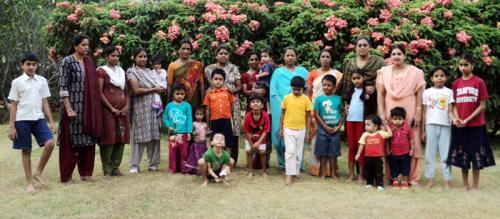
At the Creche: (From Left) Siddharth Sane, Parvathy Thangam, Ramya, Theja Prakash with Sasharika Subramanyam, Shama, Shreya, Sushilamma, Advait Sane, Aditya A. Shastry, Parvathy, Siddharth Sankaran, Ancy Mini Varghese (Deepa) with Manas, Saadhana, Indira, Abhishek Nair, Yellamma, Kaylani Sharma, Shivani Padma Kulkarni, Irabon Roy and Krishna with Umme Ara Khan (Zoha), Soumya, Shambhavi Geeta Kulkarni.

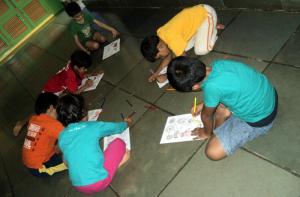
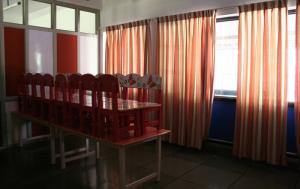

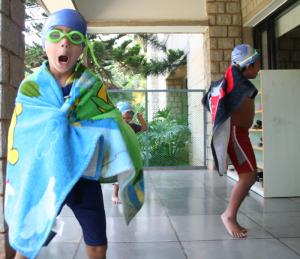
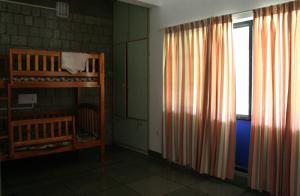
Comments
Hey Aathira, it's a nice
Thanks Manivannan!
Hey Aathira, nice article and
Thanks Bharath. It's great
Post new comment